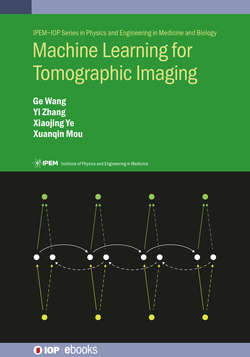Читать книгу Machine Learning for Tomographic Imaging - Professor Ge Wang - Страница 4
На сайте Литреса книга снята с продажи.
Contents
ОглавлениеForeword
Preface
Acknowledgments
Author biographies
Introduction
Part I Background
1 Background knowledge
1.1 Imaging principles and a priori information
1.1.1 Overview
1.1.2 Radon transform and non-ideality in data acquisition
1.1.3 Bayesian reconstruction
1.1.4 The human vision system
1.1.5 Data decorrelation and whitening
1.1.6 Sparse coding
References
2 Tomographic reconstruction based on a learned dictionary
2.1 Prior information guided reconstruction
2.2 Single-layer neural network
2.2.1 Matching pursuit algorithm
2.2.2 The K-SVD algorithm
2.3 CT reconstruction via dictionary learning
2.3.1 Statistic iterative reconstruction framework (SIR)
2.3.2 Dictionary-based low-dose CT reconstruction
2.4 Final remarks
References
3 Artificial neural networks
3.1 Basic concepts
3.1.1 Biological neural network
3.1.2 Neuron models
3.1.3 Activation function
3.1.4 Discrete convolution and weights
3.1.5 Pooling strategy
3.1.6 Loss function
3.1.7 Backpropagation algorithm
3.1.8 Convolutional neural network
3.2 Training, validation, and testing of an artificial neural network
3.2.1 Training, validation, and testing datasets
3.2.2 Training, validation, and testing processes
3.2.3 Related concepts
3.3 Typical artificial neural networks
3.3.1 VGG network
3.3.2 U-Net
3.3.3 ResNet
3.3.4 GANs
3.3.5 RNNs
3.3.6 GCNs*
References
Part II X-ray computed tomography
4 X-ray computed tomography
4.1 X-ray data acquisition
4.1.1 Projection
4.1.2 Backprojection
4.1.3 (Back)Projector
4.2 Analytical reconstruction
4.2.1 Fourier transform
4.2.2 Central slice theorem
4.2.3 Parallel-beam image reconstruction
4.2.4 Fan-beam image reconstruction
4.2.5 Cone-beam image reconstruction∗
4.3 Iterative reconstruction
4.3.1 Linear equations
4.3.2 Algebraic iterative reconstruction
4.3.3 Statistical iterative reconstruction
4.3.4 Regularized iterative reconstruction∗
4.3.5 Model-based iterative reconstruction
4.4 CT scanner
4.4.1 CT scanning modes
4.4.2 Detector technology
4.4.3 The latest progress in CT technology
4.4.4 Practical applications
References
5 Deep CT reconstruction
5.1 Introduction
5.2 Image domain processing
5.2.1 RED-CNN
5.2.2 AAPM-Net
5.2.3 WGAN-VGG
5.3 Data domain and hybrid processing
5.4 Iterative reconstruction combined with deep learning
5.4.1 LEARN
5.4.2 3pADMM
5.4.3 Learned primal–dual reconstruction
5.5 Direct reconstruction via deep learning
References
Part III Magnetic resonance imaging
6 Classical methods for MRI reconstruction
6.1 The basic physics of MRI
6.2 Fast sampling and image reconstruction
6.2.1 Compressed sensing MRI
6.2.2 Total variation regularization
6.2.3 ADMM and primal–dual
6.3 Parallel MRI*
6.3.1 GRAPPA
6.3.2 SENSE
6.3.3 TV regularized pMRI reconstruction
References
7 Deep-learning-based MRI reconstruction
7.1 Structured deep MRI reconstruction networks
7.1.1 ISTA-Net
7.1.2 ADMM-Net
7.1.3 Variational reconstruction network
7.2 Leveraging generic network structures
7.2.1 Cascaded CNNs
7.2.2 GAN-based reconstruction networks
7.3 Methods for advanced MRI technologies
7.3.1 Dynamic MRI
7.3.2 MR fingerprinting
7.3.3 Synergized pulsing-imaging network
7.4 Miscellaneous topics*
7.4.1 Optimization with complex variables and Wirtinger calculus
7.4.2 Activation functions with complex variables
7.4.3 Optimal k-space sampling
7.5 Further readings
References
Part IV Others
8 Modalities and integration
8.1 Nuclear emission tomography
8.1.1 Emission data models
8.1.2 Network-based emission tomography
8.2 Ultrasound imaging
8.2.1 Ultrasound scans
8.2.2 Network-based ultrasound imaging
8.3 Optical imaging
8.3.1 Interferometric and diffusive imaging
8.3.2 Network-based optical imaging
8.4 Integrated imaging
8.5 Final remarks
References
9 Image quality assessment
9.1 General measures
9.1.1 Classical distances
9.1.2 Structural similarity
9.1.3 Information measures
9.2 System-specific indices
9.3 Task-specific performance
9.4 Network-based observers*
9.5 Final remarks*
References
10 Quantum computing*
10.1 Wave–particle duality
10.2 Quantum gates
10.3 Quantum algorithms
10.4 Quantum machine learning
10.5 Final remarks
References
Appendices
A Math and statistics basics
B Hands-on networks
